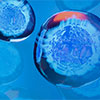BIOTIUM, INC
Catalog Number:
(75887-246)
Supplier:
Biotium
Description:
This antibody recognizes an integral membrane glycoprotein of 150 kDa, identified as CD13 (also known as aminopeptidase-N). The CD13 antigen is present on most cells of myeloid origin including granulocytes, monocytes, mast cells, and GM-progenitor cells. It is also expressed by the majority of AML, CML in myeloid blast crisis, and in a smaller fraction of lymphoid leukemias. CD13 is absent from normal lymphocytes, platelets and erythrocytes. CD13 is also present on fibroblasts; endothelial cells, epithelial cells from renal proximal tubules and intestinal brush border, bone marrow stromal cells, osteoclasts, and cells lining bile duct canaliculi. CD13 is identical to aminopeptidase N (APN), a prominent membrane-bound metalloprotease present on the surface of intestinal brush border and renal tubules. CD13 plays a role in metabolism of biologically active peptides, in phagocytosis, and in bactericidal/tumoricidal activities. It also serves as a receptor for human coronaviruses (HCV). The lineage-restricted pattern of expression of CD13 within the hemopoietic compartment suggests that it may be important in myeloid cell differentiation.
Supplier:
Biotium
Description:
This antibody recognizes the epsilon-chain of CD3 (Workshop V; Code: CD03.09), which consists of five different polypeptide chains (designated as γ, δ, ε, ζ, and η) with MW ranging from 16-28 kDa. The CD3 complex is closely associated at the lymphocyte cell surface with the T cell antigen receptor (TCR). Reportedly, CD3 complex is involved in signal transduction to the T cell interior following antigen recognition. The CD3 antigen is first detectable in early thymocytes and probably represents one of the earliest signs of commitment to the T cell lineage. In cortical thymocytes, CD3 is predominantly intra-cytoplasmic. However, in medullary thymocytes, it appears on the T cell surface. CD3 antigen is a highly specific marker for T cells, and is present in majority of T cell neoplasms.
CF® dyes are Biotium's next-generation fluorescent dyes. CF®555 is a bright orange-red fluorescent dye (Ex/Em 555/565 nm) that is compatible with super-resolution imaging by STORM.
Catalog Number:
(89493-218)
Supplier:
Biotium
Description:
Anti-IgG Rabbit Antibody (CF™ 594)
Supplier:
Biotium
Description:
This antibody recognizes a glycoprotein of ~200 kDa, identified as carbonic anhydrase IX (CAIX/gp200). Its epitope resides in the carbohydrate domain of gp200. It shows no significant cross-reactivity with other carbohydrate determinants, such as the Lewis blood group antigens, epithelial membrane antigen, HMFG, and AB blood group antigens. In normal kidney, gp200 is localized along the brush border of the pars convoluta and pars recta segments of the proximal tubule, as well as focally along the luminal surface of Bowman's capsule adjoining the outgoing proximal tubule. Reportedly, gp200 is expressed by 93% of primary and 84% of metastatic renal cell carcinomas. This MAb may be useful in the investigations of carcinomas of proximal nephrogenic differentiation especially those showing tubular differentiation.
Catalog Number:
(97065-678)
Supplier:
Biotium
Description:
A Highly Water-Soluble Cyanine-Based Dye That Yields The Brightest Fluorescence And Highest signal-to-noise ratio in immunostaining among spectrally similar dyes, such as cy*5.5, alexa fluor* 680, dylight* 680 and irdye* 680.
Catalog Number:
(89493-160)
Supplier:
Biotium
Description:
Anti-IgY Goat Antibody (CF™ 640R)
Supplier:
Biotium
Description:
MAb B-R18 specifically recognizes CD95, also known as Fas, a transmembrane glycoprotein with a MW of 40-45 kDa, containing 8 kDa of N-glycosidic-linked polysaccharide. It is a receptor for TNFSF6/FASLG, a member of the nerve growth factor receptor/tumor necrosis factor superfamily, mediating receptor-triggered apoptosis. The adapter molecule FADD recruits caspase-8 to the activated receptor. The resulting death-inducing signaling complex (DISC) performs caspase-8 proteolytic activation, which initiates the subsequent cascade of caspases (aspartate-specific cysteine proteases) mediating apoptosis. FAS-mediated apoptosis may have a role in the induction of peripheral tolerance, in the antigen-stimulated suicide of mature T-cells, or both. The secreted isoforms 2 to 6 block apoptosis (in vitro). CD95 antigen is expressed on the surface of various cell types, preferentially on the CD45RAlow CD45ROhigh subset of memory T lymphocytes.
CF® dyes are Biotium's next-generation fluorescent dyes. CF®594 is a deep red fluorescent dye (Ex/Em 593/614 nm). It yields the brightest conjugates among spectrally similar dyes, and has excellent photostability.
Supplier:
Biotium
Description:
This antibody reacts with Ig domain of CD47 protein. CD47, originally named integrin-associated protein (IAP), is a 50 kDa protein containing five membrane-spanning sequences and a short cytoplasmic tail. CD47 plays a role in both cell adhesion by acting as an adhesion receptor for THBS1 on platelets, and in the modulation of integrins. It is important in memory formation and synaptic plasticity in the hippocampus. CD47 may play a role in membrane transport and/or integrin dependent signal transduction.
CF® dyes are Biotium's next-generation fluorescent dyes. CF®488A is a green fluorescent dye (Ex/Em 490/515 nm) with excellent brightness and photostability. The dye is minimally charged for less non-specific binding. CF®488A also is compatible with super-resolution imaging by TIRF.
Catalog Number:
(75971-788)
Supplier:
Biotium
Description:
PS2, Monoclonal antibody, Clone: TFF1/1091, Host: Mouse, Species reactivity: Human, Monkey, Isotype: IgG3, kappa, BSA-free, Immunogen: A synthetic peptide from the C-terminus of human TFF1 protein, Synonyms: BCEI, Breast Cancer Estrogen Inducible Protein, Size: 50 uL
Catalog Number:
(10119-138)
Supplier:
Biotium
Description:
Secondary Antibody, Host species: Donkey, Reactivity (target): Mouse igG, Conjugation: HRP, Concentration: 1 mg/mL, Size: 1ml. Cross adsorption: bovine, chicken, goat, guinea pig, horse, human, rabbit, sheep, Syrian hamster.
Catalog Number:
(75915-992)
Supplier:
Biotium
Description:
Cytokeratin, LMW Monoclonal antibody, Clone: KRTL/1077, Host: Mouse, Species reactivity: Human, Rat, Isotype: IgG1, kappa, Conjugate: BSA-free, Immunogen: Recom human KRT77 protein, Synonyms: K1B, KRT1B, K77, CK-1B, Application: IF, IHC, WB, FC, Size: 50uL
Supplier:
Biotium
Description:
CD1A Monoclonal antibody, Clone: CB-T6, Host: Mouse, Species reactivity: Mouse, Human, Isotype: IgG1, kappa, Conjugate: CF488A, Immunogen: Human CD1a, Synonyms: Cortical thymocyte antigen CD1A, Application: Immunofluorescence, Flow cytometry, Size: 500 uL
Supplier:
Biotium
Description:
Eukaryotic histones are basic and water-soluble nuclear proteins. They form hetero-octameric nucleosome particles by wrapping 146 base pairs of DNA in a left-handed super-helical turn sequentially to form chromosomal fiber. Two molecules of each of the four core histones (H2A, H2B, H3, and H4) form the octamer; formed of two H2A-H2B dimers and two H3-H4 dimers, forming two nearly symmetrical halves by tertiary structure. Over 80% of nucleosomes contain the linker Histone H1, derived from an intronless gene that interacts with linker DNA between nucleosomes and mediates compaction into higher order chromatin. Histones are subject to posttranslational modification by enzymes primarily on their N-terminal tails, but also in their globular domains. Such modifications include methylation, citrullination, acetylation, phosphorylation, sumoylation, ubiquitination and ADP-ribosylation.
CF® dyes are Biotium's next-generation fluorescent dyes. CF®568 is a red fluorescent dye (Ex/Em 562/583 nm) with superior brightness and photostability. It also is compatible with super-resolution imaging by STORM and TIRF.
Supplier:
Biotium
Description:
ACTH Monoclonal antibody, Clone: AH26, Host: Mouse, Species reactivity: Mouse, Rat, Human, Isotype: IgG1, kappa, Conjugate: CF568, Immunogen: Synthetic peptide corresponding to aa1-24 of human ACTH, Synonyms: Adrenocorticotropin, Application: IF, IHC, Size: 500 uL
Supplier:
Biotium
Description:
Mucin 3, Monoclonal antibody, Clone: MUC3/1154, Host: Mouse, Species reactivity: Human, Isotype: IgG2b, kappa, Conjugate: CF647, Immunogen: synthetic peptide of 35 amino acids, SIB35, Synonyms: Intestinal mucin-3A; intestinal mucin-like, Application: IF, Size: 100uL
Supplier:
Biotium
Description:
Mitochondrial Marker, Monoclonal antibody, Clone: MTC754, Host: Mouse, Species reactivity: Human, Isotype: IgG's, Conjugate: CF405S, Immunogen: Semi-purified mitochondrial preparation, Application: Immunofluorescence, Immunohistology (formalin), Size: 100uL
Inquire for Price
Stock for this item is limited, but may be available in a warehouse close to you. Please make sure that you are logged in to the site so that available stock can be displayed. If the
Stock for this item is limited, but may be available in a warehouse close to you. Please make sure that you are logged in to the site so that available stock can be displayed. If the
You must log in to order restricted items. We request that you provide the required business documentation to purchase this product for the first time.
To order chemicals, medical devices, or other restricted products please provide identification that includes your business name and shipping address via email CMD_NA@vwr.com or fax 484.881.5997 referencing your VWR account number . Acceptable forms of identification are:
-Additional Documentation May be needed to purchase this item. A VWR representative will contact you if needed.
This product has been blocked by your organization. Please contact your purchasing department for more information.
The original product is no longer available. The replacement shown is available.
This product is currently unavailable but limited stock may be available in our extended warehouse network. Please call 1-800-932-5000 and a VWR Customer Service Representative will help you.
|
|||||||||


































